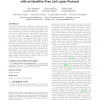112 search results - page 22 / 23 » Securely Obfuscating Re-encryption |
CCS
2010
ACM
13 years 8 months ago
2010
ACM
In this work we present a characterization of spam on Twitter. We find that 8% of 25 million URLs posted to the site point to phishing, malware, and scams listed on popular blackl...
MOBISYS
2007
ACM
14 years 8 months ago
2007
ACM
The broadcast and tetherless nature of wireless networks and the widespread deployment of Wi-Fi hotspots makes it easy to remotely locate a user by observing her wireless signals....
WWW
2010
ACM
14 years 3 months ago
2010
ACM
JavaScript is a browser scripting language that allows developers to create sophisticated client-side interfaces for web applications. However, JavaScript code is also used to car...
ACSAC
2009
IEEE
14 years 3 months ago
2009
IEEE
—Along with the burst of open source projects, software theft (or plagiarism) has become a very serious threat to the healthiness of software industry. Software birthmark, which ...
MOBISYS
2008
ACM
14 years 8 months ago
2008
ACM
We present the design and evaluation of an 802.11-like wireless link layer protocol that obfuscates all transmitted bits to increase privacy. This includes explicit identifiers su...

